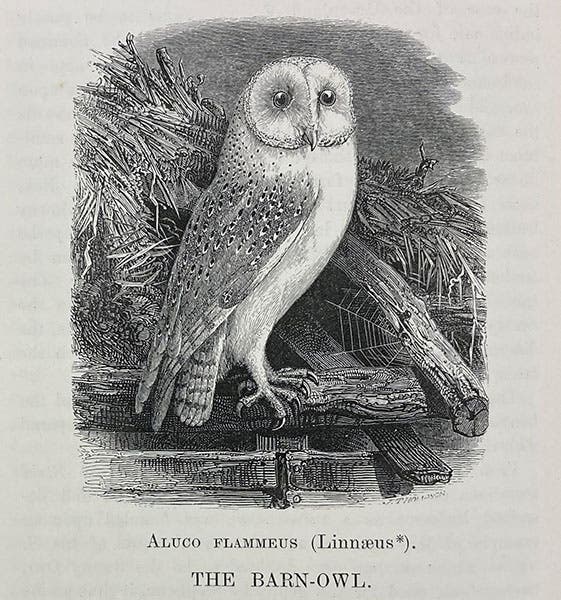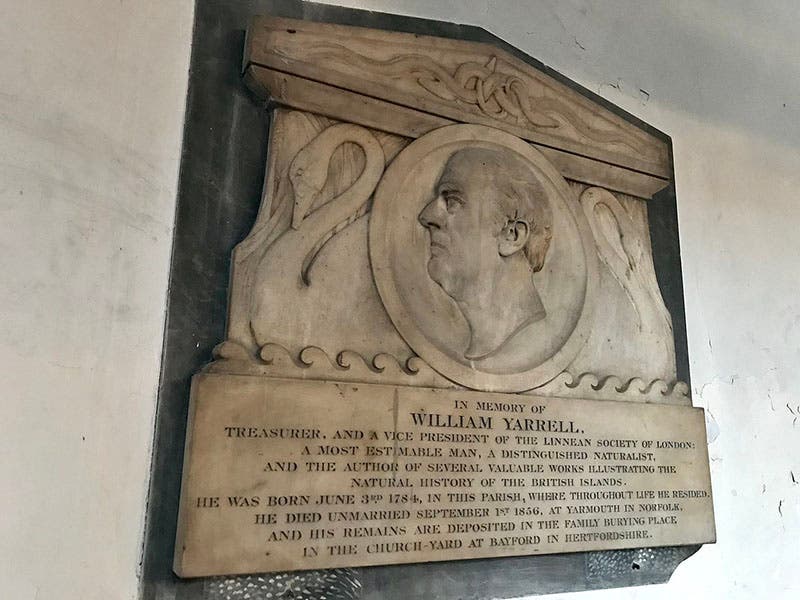Scientist of the Day - William Yarrell
William Yarrell, an English naturalist, was born June 3, 1784. Yarrell liked fish and birds, especially birds, and he liked people who like fish and birds, and that constituted his circle of friends. In addition to writing a slew of articles on such specific topics as the differing shapes of larynxes in birds and the tendency of older female pheasants to grow male plumage, Yarrell published a two-volume illustrated book, A History of British Fishes (1836), and a three-volume work, A History of British Birds (1843). These books were compiled and illustrated in the tradition of Thomas Bewick, the pioneering wood-engraver whom Yarrell knew and immensely respected. The Bewick style involved the use of small engraved wood blocks to depict a bird or an animal in great detail in a lively and interesting environment, and it was augmented by the abundant use of tiny but charming tailpieces at the ends of articles or chapters or wherever there was a bit of empty page that needed to be filled.
Yarrell's books are exactly like that, although he did not practice wood engraving himself and had to hire good artisans to illustrate his books under his supervision. We have a second (1841) edition of his Fishes in our collections, and have only a later 4th edition of the British Birds, although we do have a first-edition 1845 Supplement to the first edition of British Birds. The supplement is noteworthy, because it shows a consideration for the reader not often displayed by publishers or authors. Yarrell had issued an enlarged edition of his British Birds in 1844, and as a bow to owners of the first edition, who would otherwise be forced to buy the second edition to get the new added material, the Supplement contains only those articles that had been added for the second edition. Buy it, at a fraction of the price for a second edition, and you were up to date. We show several images from the Supplement here, and well as its only tailpiece, depicting the entrance to the city of Uppsala, home of the great Carl Linnaeus (sixth image).
I have also included several images from our fourth edition, because it used the original woodblocks of 1843, and because some of the cuts illustrate the beauty of wood engraving better than any of those in the Supplement. The great auk (first image) is not only well drawn, but poignant, because when this print first appeared in 1843, the great auk was still a living species, but by the time the fourth edition was published, the bird was, sadly, quite extinct. The barn owl is included because it is such a beautiful engraving of a striking bird (fifth image, below). I don't know what it is about the barn owl, but it seems to draw out the best from illustrators. When we published a post on George Rowley a month ago, a colored lithograph of the barn owl was our lead image.
One of the engaging features of Yarrell's bird entries is that Yarrell did not write about a species in general, rather, he wrote about the particular specimen that was illustrated – where it was found, who shot it, where it might have come from, if it was not native to the area, and how it might differ from others of that species, and related species. He discussed others who had studied or drawn other specimens – the names of Bewick and Prideaux John Selby often appeared – and where their specimens came from. It is a very folksy kind of ornithological prose, and entertaining to read, because it is so personal. He was not quite as engaging as Gilbert White of Selborne, but who was?
One of Yarrell's minor contributions to ornithology was to identify a new species of swan in the 1820s and name it after his hero, Thomas Bewick. Bewick's swan was first pictured in Selby's Illustrations of British Ornithology (1833), before Yarrell included it in his 1843 History of British Birds. We show the wood engraving from our later edition – Yarrell chose to portray just the head and neck (seventh image, below). Selby and Yarrell were good friends, and Yarrell thanked Selby along with Bewick in the preface to his History of British Birds.
There are four portraits of Yarrell in the National Portrait Gallery, but we chose to include here the lithograph by Thomas Maguire, made in 1849 (second image). Maguire did some 60 portraits of British scientists between 1848 and 1852, on commission from the Ipswich Museum, and we have included many of the “Ipswich portraits” in these posts. We have only one of these in our own collection, a portrait of Henry de la Beche. Otherwise, we rely on the National Portrait Gallery collection.
William Yarrell lived his entire adult life in a house near Piccadilly in London, not too far from the news agency that he inherited from his father and which provided a modest income throughout his life. He attended St. James Church in Piccadilly, and when he died, his friends commissioned a memorial for Yarrell to be installed in the church. It appropriately shows a relief portrait of Yarrell, flanked by two of his favorite birds, a pair of Bewick swans (eighth image)
William B. Ashworth, Jr., Consultant for the History of Science, Linda Hall Library and Associate Professor emeritus, Department of History, University of Missouri-Kansas City. Comments or corrections are welcome; please direct to ashworthw@umkc.edu.














